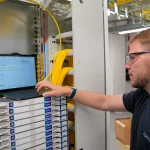Openreach Tweak Stop Sell Rules in Copper to Fibre Switch Areas

Openreach (BT) are making some tweaks to the “stop sell” rules in UK exchange areas that pass the 75% coverage milestone for their new 1Gbps Fibre-to-the-Premises (FTTP) broadband ISP network, which is the point at which the migration from older copper to fibre services can be triggered. The change adds some flexibility for FTTC lines.
As above, the process for moving from copper to fibre (see progress so far) begins once 75% of premises in an exchange are able to receive that full fibre connectivity. The target for this is often c.24 months after the fibre roll-out starts, while the copper switch-off might then occur c.3 years after that (consumer migration is a slow process). The pace of this progress may vary from place to place, as some areas have better coverage than others and ISPs are at different stages of readiness.
The migration process itself usually starts with a “no move back” policy for premises connected with FTTP (i.e. no going back to copper), followed by a “stop-sell” of copper services to new customers (12-months’ notice is usually given before this starts) and ultimately full withdrawal.
Advertisement
However, BT Group’s recent decision to raise their £15bn FTTP coverage target to 25 million UK premises by December 2026 (here and here) has also prompted a review of Openreach’s stop sell policy for exchanges that reach the 75% coverage target.
What’s Changing?
The stop sell policy is being amended to allow end customers that already have an active Fibre-to-the-Cabinet (FTTC / VDSL2) or SOGEA (FTTC broadband-only) service to change ISP and remain on the 40Mbps (10Mbps upload) FTTC or similar SOGEA service.
In addition, end customers that already have an active FTTC or SOGEA service will be able to bandwidth modify to a 40/10 FTTC or SOGEA service. Previously, both scenarios were restricted under stop sell policy rules.
The idea is that, by allowing consumers to continue to have access to FTTC on the slower tier, Openreach and ISPs will be able to focus their service effort and resources on customers who are looking to upgrade their speeds and reliability. This will also help ISPs that aren’t yet at the stage of being able to mass migrate customers to FTTP in these exchanges, which is a tricky process to do in bulk and can run into problems.
Advertisement
An Openreach Spokesperson said:
“Having upped our Ultrafast Full Fibre target to 25m, we’re keen to focus our service and resources on upgrading customers to Ultrafast speeds – so we’re making some small changes to our stop-sell policy.
Under the changes, customers in an active stop-sell exchange area who are already on a basic 40Mbps ‘Superfast’ (FTTC) service will be able to switch provider without having to migrate to our Full Fibre (FTTP) network. Existing FTTC customers will also be able to change to a basic 40Mbps service without being forced to migrate onto Full Fibre.
Having consulted our Communications Provider (CP) customers, we believe they’ll welcome these changes. It means they’ll continue to have access to the regulated ‘anchor’ 40/10 FTTC product where an FTTC line has been installed and it means they can continue to compete for customers with cheaper ‘superfast’ products, at a time when many are preparing to migrate more customers to our new digital Full Fibre network.”
The change will take effect from 18th September 2021 and will apply from that date to exchanges already under the stop sell policy, as well as on a go forward basis to exchanges where stop sell is implemented.
Openreach are making some changes to their stop sell systems and processes to facilitate this change, but these changes will not require mandatory ISP consumption and will enable providers to place orders for the scenarios described above once stop sell is implemented.
However, we can’t help but wonder whether this may push the final withdrawal of copper services in each exchange area back a bit, since FTTC services will end up being retained for a bit longer. But Openreach is of the view that it won’t, at least not significantly, because few people would wish to downgrade in order to stay on copper (they hope) and the option to upgrade to FTTP will still be there for when they’re ready.
Mark is a professional technology writer, IT consultant and computer engineer from Dorset (England), he also founded ISPreview in 1999 and enjoys analysing the latest telecoms and broadband developments. Find me on X (Twitter), Mastodon, Facebook, BlueSky, Threads.net and Linkedin.
« ISP B4RN Extend Rural Full Fibre Network to 17,000 UK Premises






















































I understand the PSTN switch off, and the eventual copper retirement, but I’m still not clear on how areas such as mine will be dealt with. Currently >75% of the exchange area are FTTC, with the remainder on EO ADSL lines. The reason that the EO ADSL lines haven’t been upgraded is that it is just too expensive (I have tried various schemes to no avail).
I can imagine that the FTTC properties will get FTTP, but the EO lines will still be too expensive to justify commercially. They will (hopefully) get an AltNet FTTP service through BDUK subsidy, which would make them even less commercially viable for OR/BT – so how will OR deal with it? Will they wait for customers to move the the AltNet and then abandon those lines altogether, or what?
It needs to be >75% FTTP, not FTTC.
Even when FTTP coverage reaches 75%, there will be no “stop sell” on copper services for the remaining 25% who can’t get FTTP.
However, in the end it will become too expensive for Openreach to maintain the whole exchange infrastructure for a small number of EO lines, at which point I’d expect them to bite the bullet and finish the rollout. They’ll need to be able to force the remaining users over to fibre within a reasonable timeframe, of course.
For users who are on FTTC it’s less important: once the analogue voice PSTN is gone (due to be completed by 2025), the cabinets can continue to serve end-users even if the exchange has vanished.
Yes, I know it needs to be FTTP – but my question is what happens to the residual non-FTTP properties. It has not been cost effective to upgrade them yet, and I can’t believe it will get more commercially viable – other than the cost of maintaining an ADSL service from a small local exchange becoming less commercially viable over time.
They remain supported until fibre comes. I suspect the UK will be dealing with the final phase, full copper removal, until well past 2030.
This is where the Universal Service Obligation kicks in. Even if a line is not commercially viable, Openreach have obligations to (a) subsidise installing a new line to the tune of at least £3,400, and (b) to not withdraw your USO service without replacing it.
Thus, Openreach has two choices:
1. Provide you with a new service (FTTP, SoADSL) that meets the USO.
2. Keep your existing service running, even though it’s not commercially viable.
Which of those they choose will depend on the meaning of “commercially unviable”; is it cheaper to replace your service, or to keep it running?
“but my question is what happens to the residual non-FTTP properties”
Nothing.
The stop sell only affects those with FTTP available.
Anyone without FTTP available will continue to be allowed to purchase ADSL/FTTC packages as normal.
“1. Provide you with a new service (FTTP, SoADSL) that meets the USO.” – 4G meets the USO, so is that an option for them?
Don’t forget Simon, that USO allows for 4G / FWA to be used.
I guess they’ll have to do what they did in Wales.
Under the “Superfast Cymru” program a few years ago, EO lines were routed via cabinets installed at the exchange’s fence.
Meaning my 900m-ish EO line currently begins with maybe 50m of fibre before reverting to copper for the rest of the route.
Happily, Openreach’s FTTP rollout has reached my town and telephone pole, and will reach my house next Monday.
“EO lines were routed via cabinets installed at the exchange’s fence.” – that’s what they did here, except BDUK wouldn’t pay for any bundles where some lines wouldn’t get 30Mbps to be rerouted, so they are still EO lines. I guess OR could reroute the remaining EO lines via the FTTC cabinet which would then allow them to get rid of the (small) exchange building.
“I’d expect them to bite the bullet and finish the rollout” – but will they? It is too expensive now, when they still have customers that would use the service. Many have already have or are likely to move to 4G or AltNet services. So I can’t believe that when they have very few or no customers that they will then decide to build an unjustifiably expensive FTTP network.
@ AnotherTim. How many EO lines are in your area? There are hundreds in my area on housing estates, no fttc cabinets, for that part of the area.
What about people who are not allowed any Broadband connection with the copper lines, we have had FTTP cables on our post’s fitted back in July 2018.
This has been cancelled, it was part of the BDUK.
THE LACK of pu keep on the inferstuctur.
I’m in a rural area. The exchange area has ~630 FTTC properties in the village (which soon will also have FTTP from Gigaclear), but the outlying properties around the village (maybe 150?) still have EO lines. Although there quite a lot of EO properties, they are spread out such that no CFP has been viable. They should get Gigaclear FTTP under the BDUK scheme eventually…
This will be the first adjustment of many for such a ‘policy’. How long will 25% of customers not be able to order the new service?
Perhaps, ‘we will be endeavouring not to extend cabinet capacity but provide full fibre instead, but existing customers will be able to take all the options available to them from the cabinet until a full fibre service is available’. This will be one way of dealing with contention for space on poles.
Ofcom are obliged to review the USO specification at some stage.
If EO lines were granted a decent USO then that’s over £1m per cabinet on top of commercial investment which should cover FTTP provision.
The debate may be whether come 2025 if this should simply go to OR as the current USO provider or to an Alnet who has say covered 85% of a location.
The Digital Economy Act 2017 sets out two mechanisms which enable
the UK Government to initiate a review of the USO
• A discretionary power that allows the Secretary of State to direct Ofcom to review the USO at any time (after consulting with Ofcom).
• A requirement that the USO be reviewed when the uptake of superfast broadband (30 Mbps or more) reaches at least 75% of UK premises
The government may not want this to happen until gigabit capability has increased in all areas, provider cost models are more mature and the full extent of providers plans are known to avoid unnecessary subsidies. So it will come but maybe not until 2024/2025.
In the meantime OR (and BT PSTN closure) will be progressing where EO lines prevent their copper/exchange closure which will be those areas of high FTTP coverage.
Hi all, my avenue is totally overhead feed E/O dps, I though no chance of FTTP.
To my amazement, an army of contractors have decended on Birmingham Woodgate Exchange area CMWDGT there are works gangs clearing duct blockages, installing new duct and boxes.
They appeared in the avenue built a new footway box by the middle pole in the avenue, and then they have have provided fibre on every pole. We have received an email from OpenReach say please contact you ISP to get FTTP services, I am with BT and they also are chasing me to go FTTP, but I am half way through my current contract.
Also on the main Hagley Road West, all the premises are UG feed, gangs arrived installed poles and provided fibre, it would appear OR are going non stop to clear Woodgate exchange in order to sell the current building.
I have also note that in Birmingham Harbourne CMHARBO exchange area loads of poles are now fibre feed.
Just tell your existing provider you want to upgrade to fttp
I live in a county town, on the main road, which has full fibre to the majority of properties down that road. Except mine. I moved into my flat in September of last year and was told by their staff that I would get an upgrade anywhere between 2 to 6 months. Its the back end of June and I’m still waiting. Bt have consistently missed the bare minimum speed I’m supposed to receive, and if I go online they can apparently supply my flat with fttp. I am waiting for the day when my Internet connection will be 16meg, let alone 1 gig.
The “no move back” policy that you refer to is, as I understand it, the “fibre priority programme” that the openreach checker reports.
Everyone thinks “the exchange is NOT part of the current fibre priority programme” means that they’re never going to get fibre. BT Local Business tell people that it means this as well.. when trying to sell leased lines.
I ordered full fibre from BT, guys came and installed the fibre connection from the telegraph pole to my new home, I had just moved home and was already with BT. The copper line was removed and the fibre installed but no signal, there were no signals at all on any fibre link at the pole, the following day one of the techs came and traced it back to the exchange. He couldn’t find the equipment in the exchange. It’s now possible that the equipment isn’t installed so I have been sold full fibre and it appears that its not even installed at the local exchange.
Also it appears that I am the 1st person to take the full fibre service as there are no records for problems with anybody else.